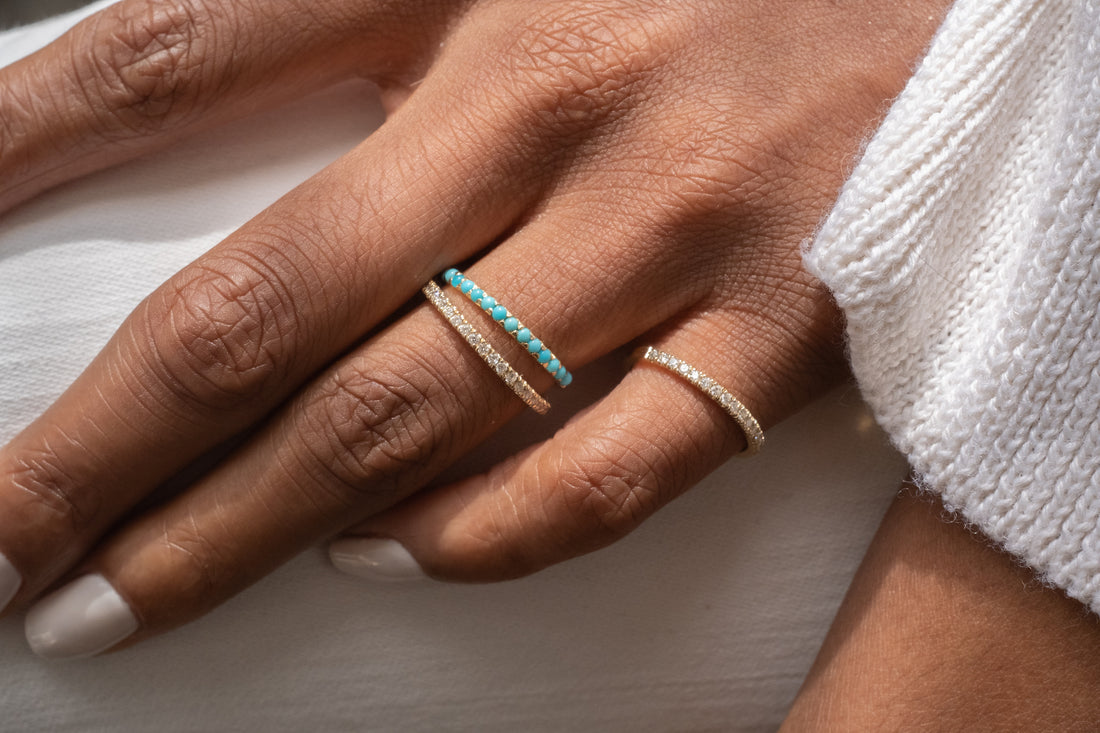
TURQUOISE: THE TRANQUIL STONE
TURQUOISE, ALSO TREASURED AS THE WORLDLY STONE OF PROTECTION
December babies, your birthstone is turquoise! As a symbol of love and protection, turquoise is also the traditional gemstone for 5th and 11th wedding anniversaries.
 So which came first -- turquoise the color, or turquoise the stone?
So which came first -- turquoise the color, or turquoise the stone?
Actually, neither! The word "turquoise" is believed to have been derived from the Old French term "pierre turquoise" which means "stone of Turkey" or the German term "turkisher steins" which means "Turkish stones." During the 16th century, Europeans mistakenly believed that the turquoise gemstones that were bought from Turkish traders actually originated in Turkey – thus named derivative – when in fact those specific stones actually originated from Persia.
CHEMICAL COMPOSITION
So what is turquoise really? It is a hydrous phosphate of copper and aluminum that creates this beautiful stone found in nature. Turquoise is formed over the course of millennia, through a chemical reaction that occurs when water leaks through rocks which contain specific minerals, such as copper and aluminum. The amount of those various minerals in the rock determine the gemstone's shade.

Photo by Géry Parent, Karkaralinsk (Qarqarly ; Karsakpaj ; Qarsaqpaj ; Kaskelen), Karkaralinsk Region, Karagandy Province (Qaragandy Oblysy ; Karaganda Oblast’), Kazakhstan
HISTORY OF TURQUOISE
This mystical gemstone is the oldest stone used in jewelry. It has been mined for thousands of years by various cultures, with evidence suggesting that the ancient Egyptians mined turquoise as far back as 6000 B.C.E. Today, turquoise is mined in a number of countries including the United States, Iran, China, and Tibet.
 |
 |
| Photo courtesy of the Met Museum, Pommel in the shape of coiled animals ca. 3rd–1st century B.C. | Photo courtesy of the Smithsonian National Museum of Natural History, Arizona, United States, North America, Turquoise - Primary Gem |
Turquoise has been treasured throughout the ages by cultures across the world for its vibrant blue color that occurs so rarely in nature. In ancient Persia, the wearing of turquoise talismans was believed to protect the wearer from death. It was also believed – not only among Persians but also in a number of other cultures – that a sudden change in the color of the turquoise gem was a sign of danger or illness. Perhaps this unique ability to change color over time is why so many cultures have treasured the gem as holy, from the the Persian Empire and Chinese dynasties, to Native Americans across the United States such as the Apache and Navajo tribes, to the royal families of Europe.
 |
 |
Turquoise is famously featured in King Tutankhamun’s golden death mask and the Queen Mother of England’s “Triumph of Love” tiara of intricately designed diamonds and Persian turquoise. The Diadem of Empress Marie Louise (second wife of Napoleon Bonaparte) was famously redesigned by Van Cleef & Arpels in the 1950's to replace the 79 emerald stones with turquoise. Now owned by the Smithsonian Institution, the diadem features a stunning total of 540 carats of the finest quality Persian turquoise alongside 700 carats of old mine cut diamonds.
Our favorite turquoise treasures? This turquoise bead bracelet because 15% of profits are donated to No Kid Hungry.

